How to clean the oven at home from grease and carbon deposits?

The oven is an integral part of modern kitchens. It can have any set of functions and have a completely different design, but sooner or later every housewife is faced with the need to clean the interior of the oven, and this is where various problems and difficulties can arise.

Security measures
First of all, when cleaning, you need to take care of your safety. After all, you can easily get a burn or other injury here. So, there are several simple rules that will help you clean the oven quickly, easily and safely:
- When starting cleaning, you need to take care of protecting your skin from burns, from exposure to, at times, aggressive cleaning agents, so the first rule is to use gloves, you can also use special protective glasses that will protect your eyes from possible splashes of cleaning agent.
- Most ovens, and even stoves in general, are powered by electricity today, therefore, before you start cleaning the inside of the oven, you must unplug the device, otherwise the ingress of water or a cleaning agent can provoke a short circuit, damage to the device and various injuries.

- When using chemical cleaning agents, ensure that the room is sufficiently ventilated to avoid respiratory tract burns and intoxication.
- In addition to airing the room, you should also take care not to inhale the vapors released by chemical agents.
- Another important rule that will help to avoid injury, as well as maintain the working condition of the equipment, is refusal to wash the heating element of the oven itself, but if it has accumulated a sufficient amount of dirt on itself, it is better to clean it with a dry cloth or soft cloth.

Choosing funds
There are many oven cleaners available today. They distinguish both chemical agents from various manufacturers and folk methods, the variety of which also boggles the imagination and opens up scope for creativity in this area of activity.
Among the most popular chemicals, various ratings distinguish the following products:
- "Shumanit"... The detergent, which is produced in Belgium, is distinguished by the ability to dissolve even old dirt, however, it contains quite aggressive substances in its composition, which, upon contact with the skin, can leave painful damage on it.
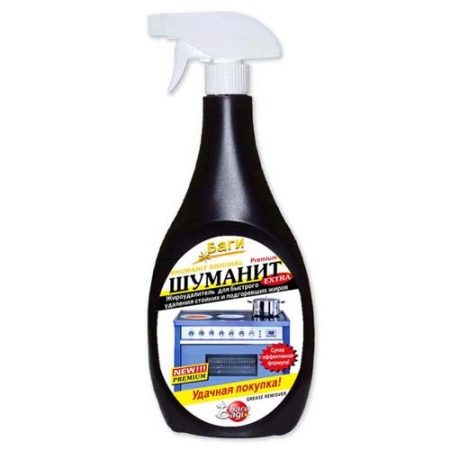
- Also, a fairly popular detergent from Amway... This product is also produced in Belgium, contains the same active substances as Shumanit, which means that it has the same properties, cleans old fat. In addition, "Amway" is convenient to use for cleaning other surfaces: for example, it can be applied to the surface of hoods, stoves, sinks and even pots.


- One of the cheapest, but at the same time effective means, is called a Hungarian development with an unpretentious name - Cif Anti-Fat. It really removes dirt, including already old stains, however, it has an unpleasant chemical odor, and can also damage the skin if it comes into contact with it, therefore, when using this product, you must equip yourself with gloves and also thoroughly ventilate the room.
- As for Russian production, it is worth noting two products that combine low cost and high-quality surface cleaning: SanitaR and special cleansing foam Unicum Gold. Both products actively deal with dirt both in ovens and on the stove, as well as in the hood, pots, pans. However, while the first agent can be used on all surfaces, the second is not suitable for paint and aluminum.



The active substances contained in the foam have a negative effect on these coatings and may compromise their integrity.

Among the publicly available folk remedies, the options most beloved by users are also highlighted:
- So, most often they use regular soda, it is inexpensive, however, it is very well able to cope with cleaning glass surfaces, so soda is indispensable in the process of cleaning the oven door. The cleaning process when choosing this tool will be as follows: the glass surface must be wiped with a damp sponge, soda must be poured onto the wet surface with a thick enough thick layer, lightly rubbed, spreading the soda over the surface and left for an hour. After the time has elapsed, use a damp sponge to remove the remnants of the soda crust and wipe with a dry cloth. For a shine and clarity finish, you can use a glass cleaner after the baking soda.
- You can also clean the surface lemon or citric acid... Lemon or citric acid can be used for cleaning both alone and in the company of other folk remedies: for example, vinegar and soda are often used, this combination enhances the effect of acid and cleaning is somewhat faster.

- There are several cleaning methods using lemonhowever, the most common is by far the simplest method. For its implementation, it is necessary to squeeze the juice out of the lemon or take citric acid and dilute it with warm water, after which the resulting liquid must be applied to the surfaces requiring cleaning and left to act for thirty minutes.After the lapse of time, the oven just needs to be wiped with a dampened sponge, all dirt should move away from the surface without effort.
- You can also clean the oven ammonia... As for the cleaning methods, ammonia can be used by analogy with a lemon solution, it is just that the exposure time is better to increase by several hours, or even overnight, or you can simply put a container with ammonia in an oven preheated to 100 degrees. In addition to this container, you will also need a container with water, it can be brought to a boil while heating the oven.
Leave the oven turned off with two containers overnight; in the morning, all that remains is to remove the dirt that has already gone away.

How to wash the inside?
There are usually no problems with washing the outer door of the oven; in extreme cases, it can simply be cleaned with a glass cleaner and a damp sponge for the rest of the surfaces. The interior of the oven is not so easy to clean, it collects more cooking grease, so cleaning takes more time and effort.
There are many ways to clean the inner space of the oven: various soaking, boiling, sanding, which housewives do not resort to in pursuit of the cleanliness of the oven. However, difficulties in cleaning can be completely avoided if you do not accumulate greasy deposits for a long time, it is enough to simply wipe the inner surface of the oven after each cooking, and timely washing of the oven racks and trays will help to avoid difficult cleaning.

A significant accumulation of fat and carbon deposits occurs on the glass of the oven, so it must also be cleaned, for this you can use ordinary soda, which must be applied for half an hour on a damp glass, then wiped off with a soft cloth moistened with water. Also, in this case, you can use a glass cleaner or special household chemicals designed to clean stoves, ovens, and hoods.
If carbon deposits and grease in the oven are already long enough guests and you simply cannot wash them, you will have to make a lot of effort to make the stove shine with cleanliness. And not only for the sake of cleanliness, general cleaning is carried out in the kitchen assistant. Fat burnt to the walls of the cabinet will sooner or later begin to burn, and this will entail both an unpleasant burning smell in the kitchen and spoilage of dishes that will be cooked in such an oven.
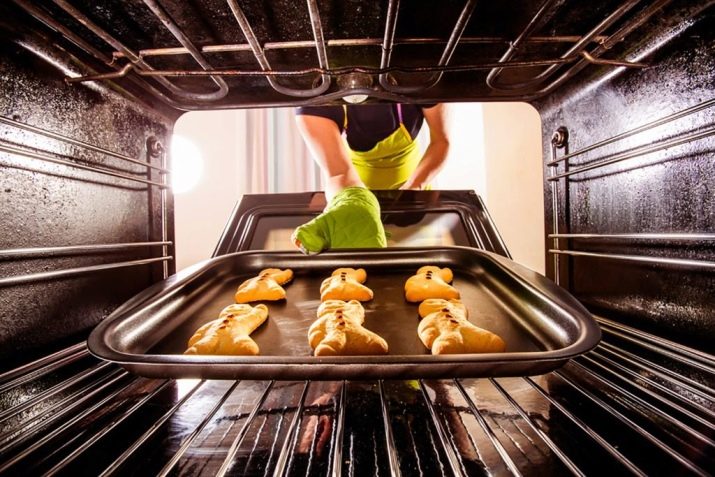
So the easiest way is buy a special cleaning agent in the store, which will be suitable for the surface that the oven has. For example, there are products for enamel, aluminum, glass and other surfaces. The selected agent must be applied with a soft cloth or sponge to the entire contaminated surface, excluding the heating element during washing.
With this method of washing, it is worth remembering that after using chemicals, it is imperative to ensure the ventilation of both the kitchen and the oven itself, this will help eliminate the negative effect of chemistry on a person.
However, given the fact that even after a seemingly thorough rinsing of the product, it can remain on the surface and affect health from a negative point of view, as an alternative, special folk methods of cleaning the surface from contamination can be determined.

Folk ways
Why do folk remedies for cleaning not lose their popularity in the modern world? Everything is very simple. Folk remedies, unlike the chemicals offered in stores, do not contain aggressive chemical elements, which means they are much safer for health. Is it worth the risk when the result is still the same? In addition, the use of folk remedies saves the budget, because the components for this kind of cleaning are very cheap, and indeed, they can be found in the arsenal of any housewife.
The only drawback of these methods is a rather long time for the procedure, it usually takes from 40 minutes to 8-10 hours, depending on the chosen method and the degree of contamination. A closer look at the various folk ways to clean the oven will help you choose the most suitable one. an option that can help quickly and effectively get rid of dirt:
- The use of soda, it can be used both dry and in solution. Both conditions can help with cleaning, and baking soda is usually suitable for any type of surface and does not harm even the most demanding materials. In order to rid the oven of fat and carbon deposits with the help of soda, it is necessary to apply a solution or powder to contaminated surfaces, leave for half an hour, and then wash the surfaces with a damp sponge until the soda is completely washed off.
You can also easily clean the oven door, for this you need to wet the surface, apply baking soda, leave for a better effect for 15-20 minutes, and then rinse with warm water. The same method can be used to clean the top of the stove.


- Everyone knows that the composition baking powder for dough regular baking soda is included, so a couple of sachets of baking powder will also help deal with dirt. The procedure itself is completely similar to that carried out when using soda: it is necessary to moisten all structural elements that need cleaning, fill them with baking powder and leave for an hour to interact. After that, using a hard sponge, it is required to remove the baking powder from the surface along with the detached dirt.


- You can remove old burnt fat from the oven using a simple vinegar, the cost of such an assistant in stores is small, and the effect is enough to get clean kitchen appliances at home. Since vinegar is a gentle cleaning agent for all kinds of surface cleaning, it can be easily used to clean both gas and electric ovens. The processing technology is very simple, you just need to abundantly moisten the sponge with vinegar and distribute the liquid from the inside of the oven and to all other elements.
After that, it is necessary to leave the oven for several hours for the best action of the product, after which it will be easy to clean even a very dirty surface from burning and old fat, yellow oily plaque is also easily removed using this method.


- You can wipe off a heavily soiled surface using mixtures of the two previous substances. Even the most difficult stains can be removed with baking soda and vinegar. The application technique will be exactly the same as in the version with ordinary soda, however, the surface moisture is not given with the help of water, but with the help of vinegar. The contaminated surface is treated with a sponge soaked in vinegar solution, and a soda layer is applied on top, after several hours of exposure to the oily surface, it is necessary to wash off the applied products and enjoy cleanliness.
- A lemon or a banal lemon acid. By abundantly wetting contaminated surfaces with lemon juice or citric acid diluted in warm water, you can get the cleanest surface in just half an hour. In addition to the application method, there is also a method of boiling the lemon solution in the oven. To do this, place a container with an acidic solution in an oven preheated to 150 degrees and leave it to boil for about half an hour, after which you need to turn off the oven and let it cool slightly.
This method helps to soften all fried plaque, and then easily remove all traces of it in 5 minutes.
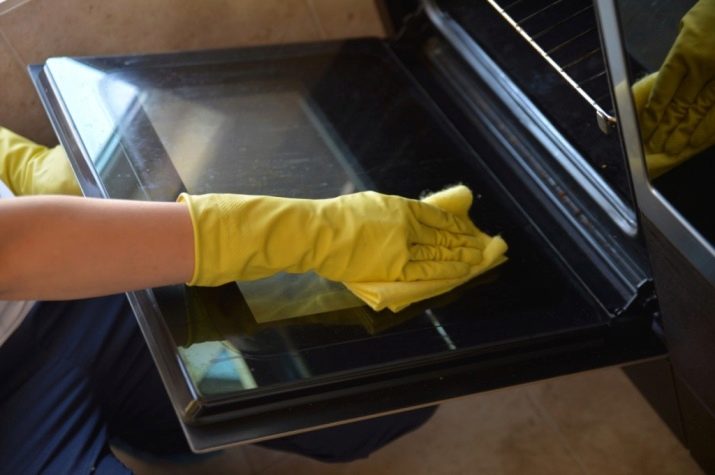
- You can also clean the oven ammonia... The method of applying the product is the same, you just need to moisten all surfaces with ammonia and leave to act for several hours.
- To clean the oven correctly and safely for health, the usual laundry soap. A small piece of laundry soap must be dissolved in a container with hot water, after which this container is sent to the oven, where the solution is boiled and steam spreads through the inner space, which softens the carbon deposits, which becomes easy to remove after the procedure.
- A dirty, baked oven can also be cleaned with a regular salt, which any housewife can find in her bins, a really penny remedy, but the effect can be compared with the most expensive chemicals. A distinctive feature of this method is its versatility, it can be used both for cleaning the internal space and external, moreover, a salt bath will help get rid of plaque and dirt on baking sheets and grates.
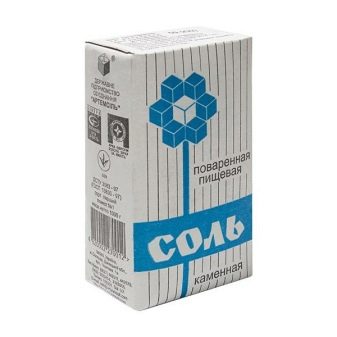

So, in order to carry out cleaning, you need to take the most common salt, it can be both coarse and fine and fill it with a baking sheet, grates and other parts of the oven. Then you should turn on the oven and heat it to 200 degrees. During the process, the salt is transformed and takes on a golden hue, as soon as this happens, the energy supply can be turned off. After that, you just need to remove the remaining golden crust along with dirt with a sponge, a weak solution of water and a gentle dishwashing detergent.
All of these funds are easy can be combined with each other: vinegar can be combined with baking soda, salt with vinegar, but vinegar is an excellent companion for laundry soap.

Steam bath
Steam cleaning is another popular option for simple and safe non-chemical cleaning. The whole process takes about three hours, but during cleaning you will not have to apply any additional efforts, no additional scraping, grinding, polishing.
So, for a procedure called a steam bath, you need simple water, a pinch of citric acid, a little vinegar or soda, you can also do with the most common table salt.
In addition to the components of the composition, you will also need a baking sheet or some kind of wide heat-resistant bowl, which will become the main element in the cleaning process.

The procedure itself is extremely simple, absolutely anyone can handle it. Even for a child, this cleaning method is not difficult:
- Water is poured onto a baking sheet or into a heat-resistant wide container with the addition of one or more auxiliary components, most often housewives prefer to use soda or vinegar. The oven itself heats up to 200 degrees, it is this temperature that will help ensure the maximum interaction of all cleaning elements.
- After the oven heats up to the desired temperature, a sheet or other dish with the selected solution is placed on the very bottom, in the process of heating the liquid, a boiling process takes place, which just creates the effect of a steam bath inside the oven.
- The boiling process should usually be kept from forty minutes to one hour, during which time the water in the oven should boil and begin to destroy the accumulated dirt.

- It is not worth opening the oven immediately after turning it off, you need to leave the container inside for a while while the oven cools down, so the effect will be even more noticeable. After cooling, it is necessary to clean off all the contaminants with an ordinary hard sponge, and since all the carbon and fat will already be sufficiently softened, this process will not cause any difficulties and questions. All that remains is to wipe the oven with a dry soft cloth and you can use a clean stove again, and, most importantly, without an unpleasant chemical smell from the use of specialized detergents.
- You can complicate the process somewhat and instead of one bowl, take two at once. In one of them, ordinary water will be poured, and it, by analogy with a regular steam bath, will be located on the lower tier of a preheated oven, but above this container you can put a bowl with a solution of ammonia and similarly bring both liquids to a boil.
- Then leave the oven to cool and let the steam do the hardest job.

However, when using ammonia, a pungent odor cannot be avoided, therefore, this procedure is recommended only in a well-ventilated room, this, of course, will not cause any health problems, unlike the chemical smell of modern products, but there is very little pleasant ammonia in a concentrated aroma.
In addition, today the market offers models of household appliances, which presuppose only steam cleaning in advance, there are special recesses in the lower part for easy installation of a baking sheet with water, as well as a function of reduced energy consumption during the cleaning process.

Self-cleaning
For those who do not want to spend a lot of time and effort cleaning the oven, manufacturers offer models with a self-cleaning function. They will definitely have their pros and cons, as well as several varieties:
- So, the first and cheapest model is oven with so-called hydrolysis cleaning. As such, self-cleaning is not provided for in this variety, however, manufacturers still classify this type of ovens as a self-cleaning subtype, and this is not accidental. All walls and elements of this kind of oven have a special treatment of acid-resistant enamel, which prevents fat and carbon deposits from penetrating deep into the material. In fact, it only settles on the surface, which makes it easy and simple to deal with it with a regular hard sponge and a mild detergent.

- More advanced models have the function pyrolytic cleaning. In this case, the cleaning process itself takes place at a temperature of 500 degrees. With such a critical heating, all food debris and greasy deposits turn into ash, the hostess only needs to collect its remnants with a damp cloth. All this determines a number of advantages and disadvantages of such models. So, the self-cleaning of these models is quite effective and very convenient, since for high-quality cleaning there is no need to take out all the baking sheets, grates and other additional components inside each time. Despite the tangible advantages, pyrolytic cleaning ovens have one big drawback - their cost.
Due to the use of high-quality heat-resistant and resistant materials, the price for these models is very high.

- Another type of self-cleaning ovens are the so-called catalytic models. Catalytic treatment is the continuous cleaning of the kiln by breaking down fat into carbon, water and organic compounds. This process is possible due to a special spraying with an oxidizing agent applied to the walls of the oven. The advantage of this type of oven is the fact that the cleaning itself takes place right during cooking, which means that there is no need to spend additional energy for cleaning.
Among the disadvantages of this option, one can note the rather fast combustion of a special coating, as well as the fact that it is applied only to the walls, which means that the oven door must be cleaned separately.

My glass
Before you start cleaning the glass, you need to take care of special items that are designed to protect the skin and help in the difficult task of cleaning. So, you should stock up on gloves, ordinary rubber gloves for household chores are perfect. Next, you should stock up on a small blunt scraper with which you can scrape off the dirt. A small brush can also come in handy to help you get close to dirt in hard-to-reach places.
Cleaning glass in an oven does not exclude the use of both modern chemistry and folk remedies available to everyone. As the most popular product in the chemical industry the products of the following manufacturers are distinguished:
- Amway... The company presents a highly effective cleansing gel. However, for the simplicity and speed of cleaning this tool will have to pay quite dearly.If this product is nevertheless purchased, it is imperative to carry out cleaning in a well-ventilated area.

- Another popular modern remedy can be used for the walls and interior of the stove. Cif "Anti-Fat"... It is enough to spray the product on the surface with contamination, leave to interact for 10-15 minutes, and then rinse thoroughly with a damp sponge.
- A special niche in glass and oven cleaning is occupied by Grill Net. Its main advantage is that when using it, only environmentally friendly products are used, which means that the product does not have a chemical odor, unlike its counterparts, does not cause allergies and is completely safe.

The tool also has its own technology of use: it is necessary to spray the foam over the entire contaminated surface, turn on the oven and, with the door open, heat it to 60-70 degrees, after which the remaining foam and dirt should be removed with a sponge.


As for folk methods, the easiest and most effective option for cleaning glass is a soda pillow. You should thoroughly moisten the surface of the door with water, and then cover it with soda, after 30-40 minutes, remove all the soda and thoroughly wash the wall. For extra shine and cleanliness, you can treat the glass with a glass cleaner.
For another way to clean glass in the oven, see the next video.
We clean the baking sheet
There are several different techniques for dealing with soiling on trays. To eliminate frozen fat, you can use common folk remedies:
- For fresh dirt, you can use a simple soda solution. It contains soda, a few tablespoons of hydrogen peroxide, and a regular dishwashing detergent. This mixture must be applied to the dishes for 25 minutes, then rinsed with a thick sponge under running water.
- You can also soak items in a baking soda solution for several hours. In this case, only soda and hot water are used.

- Alternatively, conventional mechanical cleaning can be used. You can use ground coffee, fine salt, or the same baking soda as a cleaning powder. However, this method is contraindicated when it is necessary to clean a glass or ceramic baking sheet, in this case it is better to use a special gentle gel, which can be bought at any household chemical store.
If folk remedies do not cope with pollution or the hostess for some reason avoids using them, you can pay attention to other cleaning methods.
If the carbon deposits and greasy layer are already old enough, then the effect of high temperatures will come to the rescue. Dirty dishes must be placed in a heated oven and filled with water. You can add salt, soda, vinegar or ammonia to the water. It is necessary to let the water boil for a few minutes, after which any, even the most old, contamination can be easily washed off with the help of the most ordinary kitchen sponge and dishwashing liquid.

How do I clean the grate?
To clean the grate, you can safely use the same methods that are used for cleaning baking sheets. Usually, if the grill is not stagnant, it can be easily washed with regular dishwashing detergent. However, if the carbon deposits and the layer of fat have persisted for a long time, more decisive action must be taken.
There is a very simple but effective way to clean the grill from old dirt.
It is better to clean directly in the bathroom or in another container that can accommodate the entire grate. So, at the bottom of the bathroom, you need to place a towel or other, well-absorbing dense fabric. It will protect the bath itself from unwanted dirt and scratches. You can get by with an old towel.


The grate itself is laid on the towel, after which it is necessary to draw enough hot water into the bath so that the grate is completely covered and plus a few centimeters of the water cap on top. Add a few tablespoons of baking soda or regular washing powder to the water, or you can use a mixture of baking soda, salt and dishwashing detergent. Such a mixture will act on dirt as quickly as possible, and cleaning will turn out to be fast and high-quality.
It is better to leave the grate in this position for several hours, however, if time does not allow for such a luxury, you can limit yourself to an hour of soaking in the solution, or you can simply monitor the temperature of the water and, as soon as it cools down completely, remove the grate. After such soaking, all that remains is to remove the remaining dirt with a thick sponge.
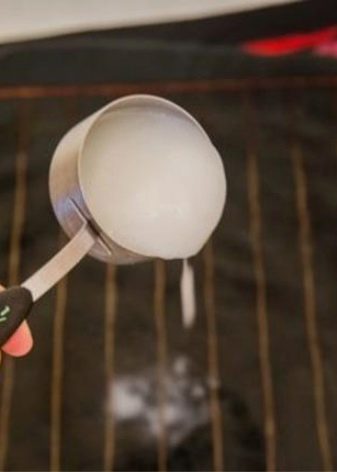
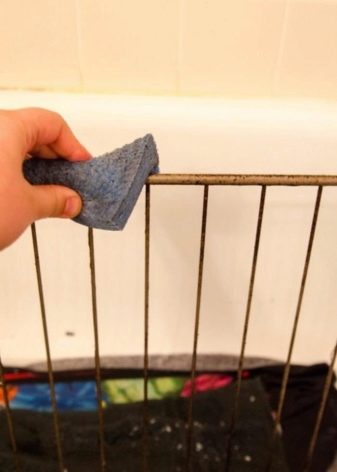
Useful Tips
For everyone who plans to clean the oven on their own at home, the following notes will be helpful:
- Under no circumstances should the heating elements of the oven be treated with cleaning agents, especially when using aggressive chemicals.
- When choosing different cleaning products in a store, you need to pay attention to which materials are suitable for certain products.
- It is better to use regular baking soda to clean the glass of the stove door, it is safe and perfectly cleans the glass surface.
- You can use a regular glass cleaner to shine the glass.
- When using chemical compounds, care must be taken to protect the skin, as well as to ensure stable ventilation of the room.









